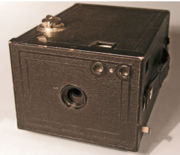
Brownie (camera)
Encyclopedia



Brownie is the name of a long-running and extremely popular series of simple and inexpensive camera
Camera
A camera is a device that records and stores images. These images may be still photographs or moving images such as videos or movies. The term camera comes from the camera obscura , an early mechanism for projecting images...
s made by Eastman Kodak
Eastman Kodak
Eastman Kodak Company is a multinational imaging and photographic equipment, materials and services company headquarted in Rochester, New York, United States. It was founded by George Eastman in 1892....
. The Brownie popularized low-cost photography and introduced the concept of the snapshot
Snapshot (photography)
A snapshot is popularly defined as a photograph that is "shot" spontaneously and quickly, most often without artistic or journalistic intent. Snapshots are commonly considered to be technically "imperfect" or amateurish—out of focus or poorly framed or composed...
. The first Brownie, introduced in February, 1900, was a very basic cardboard
Paperboard
Paperboard is a thick paper based material. While there is no rigid differentiation between paper and paperboard, paperboard is generally thicker than paper. According to ISO standards, paperboard is a paper with a basis weight above 224 g/m2, but there are exceptions. Paperboard can be single...
box camera
Box camera
The box camera is, with the exception of the pin hole camera, a camera in its simplest form. The form of the classic box camera is no more than a cardboard or plastic box with a lens in one end and film at the other. A simple box camera has only a single element meniscus fixed focus lens and...
with a simple meniscus lens that took 2¼-inch square pictures on 117 rollfilm. With its simple controls and initial price of $1, it was intended to be a camera that anyone could afford and use, leading to the popular slogan, "You push the button, we do the rest." The camera was named after the popular cartoons created by Palmer Cox
Palmer Cox
Palmer Cox was a Canadian illustrator and author, best known for The Brownies, his series of humorous verse books and comic strips about the mischievous but kindhearted fairy-like sprites. The cartoons were published in several books, such as The Brownies, Their Book...
.
One of the most popular Brownie models was the Brownie 127, millions of which were sold between 1952 and 1967. The Brownie 127 was a simple bakelite camera for 127 film
127 film
127 is a film format for still photography. The image format is usually a square 4×4 cm, but rectangular 4×3 cm and 4×6 cm are also standard. Oddly, C. F. Foth & Co. used 36×24 mm for its first “Derby” model....
which featured a simple meniscus lens and a curved film plane to reduce the impact of deficiencies in the lens.
Having written an article in the 1940s for amateur photographers suggesting an expensive camera was unnecessary for quality photography, the famous Picture Post
Picture Post
Picture Post was a prominent photojournalistic magazine published in the United Kingdom from 1938 to 1957. It is considered a pioneering example of photojournalism and was an immediate success, selling 1,700,000 copies a week after only two months...
photographer Bert Hardy
Bert Hardy
Bert Hardy was a documentary and press photographer known for his work published in the Picture Post magazine between 1941 and1957....
used a Brownie camera to stage a carefully posed snapshot
Snapshot (photography)
A snapshot is popularly defined as a photograph that is "shot" spontaneously and quickly, most often without artistic or journalistic intent. Snapshots are commonly considered to be technically "imperfect" or amateurish—out of focus or poorly framed or composed...
of two young women sitting on railings above a breezy Blackpool
Blackpool
Blackpool is a borough, seaside town, and unitary authority area of Lancashire, in North West England. It is situated along England's west coast by the Irish Sea, between the Ribble and Wyre estuaries, northwest of Preston, north of Liverpool, and northwest of Manchester...
promenade.
In 1908, the Austrian architectural critic Joseph August Lux wrote a book called Künstlerische Kodakgeheimnisse (Artistic Secrets of the Kodak) in which he championed the use of the camera for its cultural potential. Guided by a position that was influenced by the Catholic critique of modernity, he argued that the accessibility the camera provided for the amateur meant that people could photograph and document their surroundings and thus produce a type of stability in the ebb and flow of the modern world.
Beau Brownie
The Beau Brownie range was available from 1930 to 1933.They differed very little from the ever-popular Brownie cameras, the only technical difference being the introduction of a new doublet lens, allowing the same picture to be projected on a film plate over a shorter distance, making the Beau Brownies nearly 2" shorter than their conventional counterparts.
Visually, they had a different enameled two-tone front plate in a heavily geometric and contemporary Art Deco design, the work of leading American Deco designer, Walter Dorwin Teague
Walter Dorwin Teague
Walter Dorwin Teague was an American architect, designer and one of the most prolific American industrial designers in terms of volume of completed work. Teague's name and vision lives on through the legacy of his company....
.
They were available in five colour combinations: black and burgundy, brown and tan, two-tone blue, two-tone green, and two-tone rose. The rose and green cameras were produced only in1930 and 1931, and are therefore rarer than the others.
They were encased in a faux-leatherette casing.
There were two formats, the $4 No.2 and $5 2A, just like the Brownies, the No.2 measuring 2 ¼" by 3 ¼" and using 120 roll film, and the 2A measuring 2¼" by 4¼", and taking 620 Kodak roll film. The 2A had a thicker, bakelite rim and was an inch taller than the No. 2.

